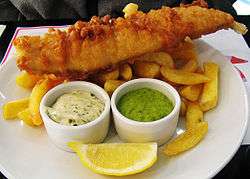Mushy peas

Mushy peas are dried marrowfat peas which are first soaked overnight in water with sodium bicarbonate (baking soda),[1] then rinsed in fresh water and simmered with a little sugar and salt until they form a thick green lumpy mash. Sometimes mint is used as a flavouring. In Northern England and the Midlands they are a traditional accompaniment to fish and chips, although their appeal has spread. All over Britain, but particularly in Northern England, they are commonly served as part of the popular snack of pie and peas (akin to the South Australian pie floater, but with mushy peas instead of a thick pea soup) and are considered to be a part of traditional British cuisine. Mushy peas can also be bought ready prepared in tin cans. They are sometimes also packed into a ball, deep-fried in batter, and served as a pea fritter.[2]
Local variants
In Yorkshire, Nottinghamshire, Derbyshire and parts of Lincolnshire, mushy peas are often served as a snack on their own. In Nottinghamshire they are traditionally accompanied by mint sauce, and sold at open-air events such as fairs or fêtes. In Nottinghamshire, mushy peas served with chips is called a 'pea mix'. Mushy peas are also popular in Scotland served with fish and chips or as a wetter version with vinegar in a bowl.
A variant (particularly popular around Bolton, Bury, and Preston, Lancashire) is "parched peas" – carlin peas (also known as maple peas, or black peas) soaked and then boiled slowly for a long time; these peas are traditionally served with vinegar.
Mushy peas have occasionally been referred to as "Yorkshire caviar".[3]
Artificial colouring
Green colouring is often used to colour mushy peas. It is typically achieved by adding the yellow and blue additives, Tartrazine (E102) and Brilliant Blue FCF (E133), which together produce the green effect. The use of artificial colours results in bright green mushy peas. Pure mushy peas, with no colouring, tend to form a more grey-green end product. Sodium bicarbonate (E500) is often added to soften the peas to enhance the colour and to inhibit fermentation during soaking, which reduces later flatulence in consuming said foods. The British Food Standards Agency, on 28 April 2008, asked for a voluntary ban on artificial food colourings and suggested that the ban would be practical by the end of 2009. This would mean that certain foods, including mushy peas, would need to be free of the additive, otherwise the item might be removed from sale.[4] Mushy peas present a particular problem since there is no alternative to tartrazine that gives it the bright green colour. Without the colourant the dish would be murky grey. Ministers have stated that they will pursue a ban through law if food manufacturers do not phase out the food colourings.[5] In July 2010 an EU directive required the warning label "May have effects on activity and attention in children" to be applied to foods containing tartrazine.[6]
See also
| Wikibooks Cookbook has a recipe/module on |
References
- ↑ Elaine Lemm. Traditional Mushy Peas Recipe. About.com. Retrieved 23 September 2013.
- ↑ "Pea fritter". Everything2.com. Retrieved 2 October 2018.
- ↑ "48 hours in Bristol / Dining with the locals", Independent, 26 April 2008
- ↑ Meikle, James (2008-04-10). "FSA calls for voluntary ban on artificial colourings". London: The Guardian.
- ↑ "UK: Ban on food additives 'supported by ministers'", Fresh Plaza, 17 November 2008
- ↑ "The Kitchen Thinker: Food colourings". The Telegraph. 7 February 2011. Retrieved 3 April 2018.